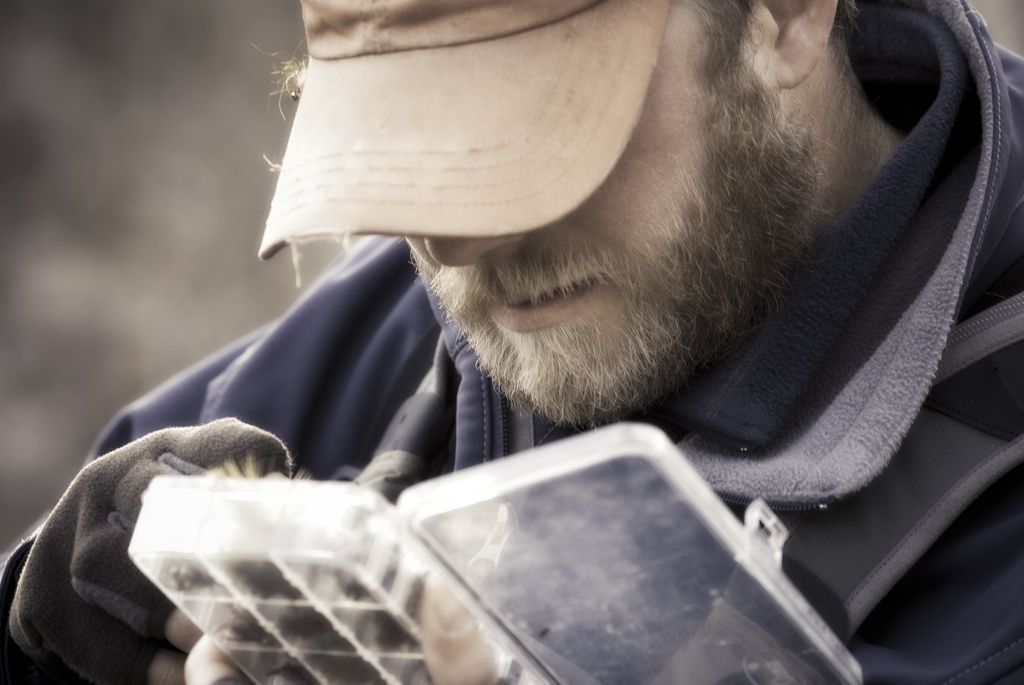How long do you fish with flies without success before you decide to change them?
I’ll usually fish for about thirty minutes with my first rig of the day, and if I’m not getting any hookups, I’ll begin regularly changing my flies out until I find a pattern that works. The willingness to change your flies on the water when your not getting bites, is often the key factor in determining whether you have a good or bad day of fishing. I can’t tell you how many times I’ve had someone walk up to me in the parking lot at the end of the day and complain about how the fish weren’t biting. While I, on the other hand, had caught and released dozens of fish in the same section of water. Most of the time that discouraged angler stuck with a few patterns during the day, and didn’t change flies enough times to find out what patterns were really working. How do I know this? I know this because I was that discouraged angler many times early on, in my career.
It can be very obvious to us that changing flies is the answer when we’re able to sight-fish and see fish rejecting our flies. But many times you’ll find yourself fishing in conditions where sight-fishing isn’t an option. A few examples is when your fishing fast moving choppy water, water with significant glare, and stained water conditions. None of these will provide anglers the opportunity to get visual feedback. In these conditions, anglers should change their flies when they’re not getting bites for extended periods of time. If you know your rig is set up correctly (correct tippet size, fly size, split-shot amount, or indicator placement) for the specific water your fishing, and your making good presentations, a light bulb should be going off in your head telling you to change fly patterns if your not getting bites.
Sometimes you’ll find a single pattern will work for you the entire day when there’s a hatch that fish are keying in on. However, when there’s not a hatch or specific bug that the fish are keying in on, you may find that one pattern will work in one hole and the next spot it won’t work at all. In this situation, you should be prepared to change flies from one hole to the next to consistently catch fish. The best advice I can give anglers is don’t be lazy and stick with fishing flies that aren’t producing. Furthermore, anglers should always be ready for the food menu to change throughout the day. Certain species of aquatic bugs and forage food are more active during different times of the day. That means some patterns will work great in the morning and may not work at all later in the day. This is a curve ball that many rookie fly anglers will swing and miss at. They’ll be thinking in their head, I caught a half dozen fish right off the bat with this pattern, so I’m going to continue to fish it. Making this mistake will cost you numbers and big fish everyday on the water.
Next time your on the water and your not getting bites, change your flies until you find a pattern that works. It often is the only reason your not catching fish. If that doesn’t work, continue covering water until you find fish. A good example of this is fishing for steelhead, where you’ll find 70% of the fish in 30% of the water.
Kent Klewein Gink & Gasoline www.ginkandgasoline.com hookups@ginkandgasoline.com Sign Up For Our Weekly Newsletter!

Wonderful article well written and informative, thanks for posting it. I catch myself often presenting a fly over and over again even when I can see that a trout is feeding and not just ignoring but moving out of the path of my fly. I would think that if the fish is feeding it can be caught on something and so would begin the experimentation; how much time would you spend trying to fool a fish that you can see is actively feeding? Thanks for the great blog.
good one indeed.
I usually wonder whether I don’t catch because I’m not in the right place, or because I don’t have the right fly. hard to tell.
Being in the right place and fishing productive water is very important to your success.
If I’m not catching fish you’ll see me changing flies and covering water until find fish. By all means though, anglers should always try to stay dialed into the hot fly patterns during the day.
Kent
Pingback: Importance of Changing Flies | MidCurrent